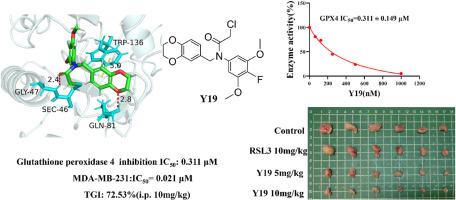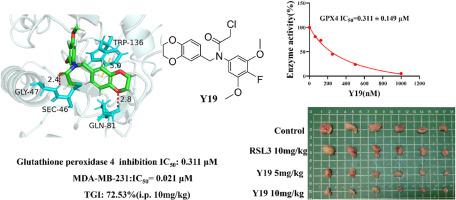Discovery of novel benzylaniline derivatives containing chloroacetamide as GPX4 inhibitors with potential efficacy in triple-negative breast cancer
IF 5.9
2区 医学
Q1 CHEMISTRY, MEDICINAL
引用次数: 0
Abstract
Studies have found that induction of ferroptosis in tumors may become a new treatment method. Glutathione peroxidase 4 (GPX4) has become a promising target for cancer treatment by inducing ferroptosis, of which covalent GPX4 inhibitors are the most widely studied class so far. A series of GPX4 inhibitors containing chloroacetyl warheads were designed and synthesized, and the antiproliferative activity was evaluated using six tumor cell lines. Among them, compound Y19 showed strong anti-proliferative activity with high ferroptosis selectivity against MDA-MB-231 cells with IC50 value of 21 nM. Moreover, Y19 effectively inhibited GPX4 activity and molecular docking revealed that Y19 may covalently bind to Sec 46 site of GPX4. In addition, compound Y19 caused intracellular Fe2+ accumulation, leading to increased levels of lipid peroxides (LPOs) and induction of ferroptosis. This was followed by the discovery that Y19 induced ferroptosis by LPOs and reactive oxygen species (ROS) production leading to DNA damage. In vivo pharmacodynamic evaluation demonstrated that Y19 exhibited superior antitumor efficacy compared to RSL3 at an equivalent dose, achieving a tumor growth inhibition (TGI) rate of 72.53 % at 10 mg/kg in the MDA-MB-231 xenograft model, with no significant toxicity observed. This provides structurally diverse tool compounds to reveal the basic biology of GPX4 as well as to explore potential efficacy with the treatment of cancer by inducing ferroptosis.


发现含氯乙酰胺的新型苯苯胺衍生物作为GPX4抑制剂,对三阴性乳腺癌有潜在疗效
研究发现,肿瘤诱导铁下垂可能成为一种新的治疗方法。谷胱甘肽过氧化物酶4 (Glutathione peroxidase 4, GPX4)通过诱导铁下垂而成为癌症治疗的一个有前景的靶点,其中共价GPX4抑制剂是目前研究最广泛的一类。设计合成了一系列含有氯乙酰基弹头的GPX4抑制剂,并对6种肿瘤细胞系进行了抗增殖活性评价。其中,化合物Y19对MDA-MB-231细胞表现出较强的抗增殖活性,具有较高的铁凋亡选择性,IC50值为21 nM。此外,Y19有效抑制GPX4活性,分子对接显示Y19可能与GPX4的Sec 46位点共价结合。此外,化合物Y19引起细胞内Fe2+积累,导致脂质过氧化物(LPOs)水平升高,诱导铁下垂。随后发现Y19通过LPOs和活性氧(ROS)的产生诱导铁下垂,导致DNA损伤。体内药效学评价表明,在相同剂量下,Y19的抗肿瘤效果优于RSL3,在MDA-MB-231异种移植模型中,10 mg/kg的肿瘤生长抑制(TGI)率达到72.53%,无明显毒性。这为揭示GPX4的基本生物学以及探索其诱导铁下垂治疗癌症的潜在功效提供了结构多样的工具化合物。
本文章由计算机程序翻译,如有差异,请以英文原文为准。
求助全文
约1分钟内获得全文
求助全文
来源期刊
CiteScore
11.70
自引率
9.00%
发文量
863
审稿时长
29 days
期刊介绍:
The European Journal of Medicinal Chemistry is a global journal that publishes studies on all aspects of medicinal chemistry. It provides a medium for publication of original papers and also welcomes critical review papers.
A typical paper would report on the organic synthesis, characterization and pharmacological evaluation of compounds. Other topics of interest are drug design, QSAR, molecular modeling, drug-receptor interactions, molecular aspects of drug metabolism, prodrug synthesis and drug targeting. The journal expects manuscripts to present the rational for a study, provide insight into the design of compounds or understanding of mechanism, or clarify the targets.

 求助内容:
求助内容: 应助结果提醒方式:
应助结果提醒方式:


